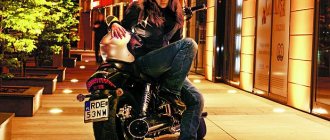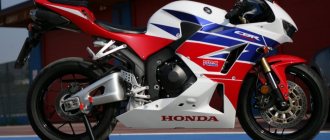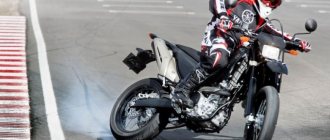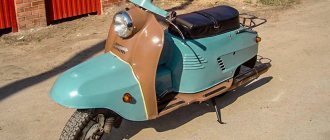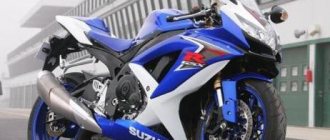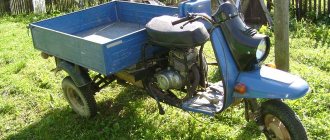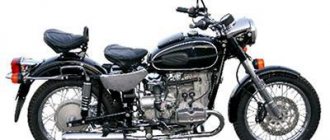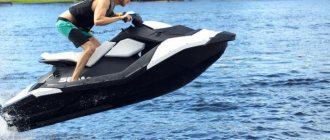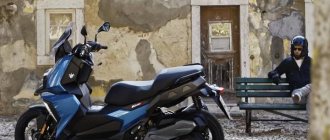08/11/2021 If you decide to buy a motorcycle, but don’t know where to start, we advise you to read our review. We will try to bring clarity to your mind - we will outline the design features and technical characteristics of different types of motorcycles, and tell you about the reasons for the appearance of each of them. Together we will figure out why this or that “iron friend” should be yours. In this matter, we will rely not on intuition, but on facts, including historical ones.
We'll bring a motorcycle from the Japanese auction!
Free consultation
What types of motorcycles are there?
A clear division of motorcycles into types does not exist to this day. It’s also difficult to name how many types of motorcycles there are. But there is an opportunity to find out why this type of vehicle has a fairly extensive classification and what became the “starting point” of today’s conditional classification.
The motorcycle became especially popular at the beginning of the 20th century. In transport, users of that time liked the sporty spirit, mobility and low cost of a motorcycle. As you know, demand creates supply. Therefore, at this time, many companies begin to conduct engineering development of new motorcycle technology.
The work does not go unnoticed: the world learns what pneumatic tires, electric lighting, spark ignition, chain drive, soft suspension, etc. are. The motorcycle gradually acquired all this, turning from a bicycle with a motor into a solid, durable and reliable transport vehicle. means.
With the advent of design schools in the States, England, Germany and Italy, motorcycles began to be ranked into groups. The main classification - on-road and off-road - remains the same. With the introduction of motorcycles into racing, various types of sports motorcycles emerged alongside cars.
The modern classification of motorcycles ranks them according to purpose, weight, engine size, control method, number of wheels, etc. Let's delve into the topic and see what the rapid development of motorcycle technology has led to, let's go over the main types of modern motorcycles and find out their "tricks" .
Historical reference
Motorcycles date back to the end of the 19th century. The very first two-wheeled iron horse equipped with an engine was the Daimler Reitwagen. It was designed in Germany by engineers Gottlieb Daimler and Wilhelm Maybach and this happened in 1885. This invention had a 260 cc engine. and power 0.5 hp. differed significantly from both the bicycles that existed at that time and from modern motorcycles. However, it was with its appearance that the development of the motorcycle industry began.
Throughout the 20th century, motorcycles were modified and became more and more advanced. Today, a bike is a vehicle on two wheels, with steering, an engine in the frame, and the driver sitting on top. But this is only a general definition. Modern bikes, depending on their purpose, are divided into various categories: road, touring, cross-country, sports.
Road
Road or universal bikes that are suitable for riding around the city and covering short distances on the highway. It was with these motorcycles that the story began. The “fathers” of modern models are still very popular and are on par with cars.
It should be noted that calling a particular motorcycle “road” or “classic” is a rather “slippery” topic. For example, the BMW company introduced the term “roadster” into the designation of its road motorcycle models (we’ll talk about it later). Despite the fact that we are talking about purely automotive topics, for several years now many specialized publications have been willingly and boldly using this designation.
Standard
The classic motorcycle or "standard" appeared before the classic car with an internal combustion engine - back in 1886. Until now, it is classified as a vehicle “for every day”.
Classic motorcycles have a special magic; they make their owner fall in love with their grace and at the same time brutality. A motorcycle with a direct pilot seat (saddle height no lower than 85 cm) and a minimum of plastic. A classic bike is usually equipped with a small number of external body kits, but is equipped with lighting equipment - you can really safely move on it on dark public roads.
All types of such road motorcycles:
- equipped with a powerful engine and modernized transmission - suitable for daily driving on city streets;
- have the same size rear and front wheels - this feature makes it easier to move on an asphalt road;
- They are distinguished by universal rubber - the combined tread is suitable for traction on any type of road.
Honda CB750
An example of a legendary classic model is the Honda CB750 motorcycle from 1969 from the Land of the Rising Sun. At the time of release, this samurai was able to revolutionize the market by introducing 4-cylinder engines, which confidently replaced the 2-cylinder engine that was popular at that time.
Road retro motorcycles from the 60s and 80s are still popular today. Despite its age, the value of such technology is only growing.
Naked
Naked or “naked” is a type of passenger motorcycle for a beginner. This bike is devoid of fairings, which in classic models traditionally cover the engine and frame. The model was created for a typical city dweller who appreciates the maneuverability of equipment - you can easily drive this motorcycle even through narrow passages.
Among the characteristic features of Naked it is also worth noting:
- free access to engine repair work and other basic elements;
- comfortable slightly inclined position of the driver on the seat;
- low speed - you won’t accelerate much on “naked” models.
If we compare the appearance of the motorcycle and its “filling”, we can confidently classify naked bikes as affordable models. The excellent price of motorcycles is due to minimalism in tuning - the costs of the production process spontaneously decrease.
Bobber
It is not difficult to guess what class this motorcycle belongs to. The bobber is a typical road bike. This special type of motorcycle began to appear in the 30s and 40s of the 20th century in the USA. At that time, motorcycle racing on a dirt track was popular. Along with the Harley, the bobber, as a class of motorcycle, has become a cult favorite for many generations of motorcycle connoisseurs.
The “trick” of this model is its simplicity. The seats, headlights, battery and gas tank have all been replaced with lighter counterparts. The essence of this tuning was to reduce the weight of the motorcycle without changing the technical and running parameters.
Over time, the bobber changed, and in the end it became an exclusively sporting attribute. The modernizations turned out to be so successful that for a long time in America bobbers were at the peak of popularity even after the advent of good roads.
The modern bobber has lost some of its charm. Today, a model may have an unusually high fork and a bulky, disproportionate muffler. A bobber in the 21st century is more pathos than practicality.
We'll bring a motorcycle from the Japanese auction!
Request a call
Roadster
Roadsters combine the chassis geometry of classic bikes with high-torque two- or four-cylinder engines. The seat height of the new type of motorcycle does not exceed 65 cm - you can sit in it not only upright, but also quite low, which increases the level of comfort over long distances.
Roadsters were created for high elasticity and dynamic power development. The model has a low curb weight: the engine chassis, frame and windshield are not covered. Since there is no skin, you won’t be able to drive at a constant speed of 160 km/h on a roadster.
The mixture of a bike and a car quickly became popular. There are three explanations for this - an unusual design that attracts attention on the road, good technical solutions, as well as a desire to demonstrate one’s wealth - such a “toy” costs quite a lot.
Cafe racer
This motorcycle is worth choosing if you plan to regularly ride at high speed over short distances. Cafe racers began to be mass-produced in the United States in 1901. The first cafe racer was created on the basis of the British Triumph Bonneville. This model is still produced, only its stylistic design changes.
The basic advantages of the technology are rapidly developing speed and excellent controllability. However, when choosing such an “iron horse”, you should immediately prepare for a minimum of comfort.
The term "cafe racer" originated in England in the 1960s as an ironic name for motorcyclists who pretended to be "cool" professional racers by parking their vehicles next to a table in a cafe.
Scrambler
One of the most extraordinary types of classic motorcycles is the dual-purpose bike. The scrambler is a stylization of retro technology. It is quite well equipped and was designed for light off-road driving.
Classic road models began to be converted into scramblers. Motorcycles were made easy and motivating. Today, such a motorcycle is not easy to find: they are practically not produced, because they consider the production of “exotic” to be an unprofitable activity.
Ducati Scrambler
The popular company Ducati nevertheless released its Scrambler, and later British manufacturers also caught up. The released bikes fully correspond to their name, however, the list of production motorcycles is still very short.
Oil bike
Stunning power and beauty in metal. This is a laconic, classic-style roadster. Of all types of road motorcycles, it is one of the fastest. On such a bike you can easily win the “traffic light race”. However, it is worth considering that these motorcycles are not inclined to turns and sudden braking.
Yamaha V-Max
It is due to the features of this model that the legendary Yamaha V-Max received the symbolic name “Sledgehammer”.
Before buying an oil bike, you should “try it on for yourself” - sit on it, feel the power and heaviness of the equipment.
https://jplife.ru/statistic/YAMAHA/OTHER/?
Cruiser
Cruisers “changed clothes” from touring motorcycles and immediately became the standard of style. The first cruiser model appeared in the USA in the 40-50s. 20th century, when fans demanded chic and brutality.
Among the characteristic features of such a representative it is worth highlighting:
- complete absence of plastic and abundance of chrome;
- seat height no higher than 75 cm, comfortable saddle, high back;
- U-shaped handlebar, forward-mounted footrest;
- two-cylinder engine, teardrop-shaped tank.
In general, the manufacturers managed to create a motorcycle that gives the feeling of riding not on an open bike, but on a luxury car. Below is a little more detail about what types of such motorcycles there are.
Chopper
The “trick” of American choppers is their expressive appearance. These are not the fastest motorcycles, but they are successfully styled to suit the owner. The main features by which you recognize a chopper: an elongated front fork, a wide rear wheel, a teardrop-shaped tank, a two-level seat and a high steering wheel, as well as leather and chrome in the design.
Power cruiser
He's a dragster. A motorcycle “tailored” for powerful grips especially for those who like cruisers, but don’t like their calm disposition. It's a motorcycle shaped around a motor. If you want pure power with sporty dynamics and a comfortable riding position, there's no better option.
Sports
Motorsports competitions were first organized in 1894. It was from this period that the classification of motorcycles into “civilian” and “sports” or “racing” appeared.
It’s worth noting right away that such bikes are designed for victory, and not for comfort, so riding them is not very comfortable. The driver has to curl up on the saddle or even lie on his stomach. Therefore, if you need a bike for everyday driving on city roads, this is not your option.
The maximum speed that this “beast” develops is 290-300 km/h. The number of engine revolutions is more than 10 thousand.
Streetfighter
This is a class of road motorcycles - the same as a sportbike, however, it is more suitable for city riding. The motorcycle is characterized by high maneuverability, excellent handling, and stability on the trajectory. Victory in the case of this model is not at the forefront. Streetfighter will appeal to those who have wanted change for a very long time, but at the same time are attached to the urban area.
Tourist
Tourers or “limousines” are very comfortable and cost much more than standard ones. Such models appeared to the world relatively recently - as soon as amateurs began to be interested in comfortable motorcycles with many functions.
Ideal transport for tourist trips. Manufacturers of trainers, full trainers, and baggers focus on comfort and safety, de-emphasizing speed and maneuverability. On such a bike you can comfortably ride up to 1000 km per day. Among the distinctive features of motorcycles, it is worth noting a high back, a soft seat, trunks on the sides, and a luggage compartment. Some models are equipped with cruise control, radio, air conditioning, airbags, and a passenger seat.
Sports and tourism
“Sport-tourist” motorcycles are sporty in appearance, but intended for long-distance travel. Such models became popular in the 80-90s of the last century. According to owners' reviews, a sports touring bike should be appreciated for its aggressive design, technology and high speed.
Modern motorcycles can be divided into three main types and eight main classes:
Type. "Road motorcycles".
Road motorcycles include :
1.1 Sports bike and super sport motorcycles .
1.1.2 Street fighter class motorcycle.
1.2 Sports tourists ( sport touring motorcycle ).
1.3 Touring motorcycle.
1.4 Classic motorcycles and neo-classic motorcycle.
1.5 Choppers.
Type. "Off-road motorcycles."
2.1 Cross motorcycles.
2.2 Enduro motorcycles.
Type. "Dual-purpose motorcycles."
3.1 Motorcycle “Dual sport”, also known as “motard”.
Off-road
It's time to talk about the second class of motorcycles - off-road. Otherwise they are called “dirt bikes” or “dirty motorcycles”. Compared to road vehicles, their design is simplified, they have powerful wheels, a lightweight frame without fairings. SUVs are equipped with all-terrain tires - this ensures excellent traction on unpaved roads. Typically, such motorcycles have a single-cylinder engine, borrowed from cross-country motorcycles.
Next we will talk about the types of such motorcycles and their purpose. They, like road ones, are divided into types completely arbitrarily.
Motocross
Motorcycles of this type were created to participate in various sporting events, in areas where the road does not even smell. Typically, such equipment is equipped with two-stroke engines. Motocross is lightweight, has a durable frame, and reliable suspension. Many models of motocross motorcycles are completely devoid of lighting technology - from a kick starter.
Good news: motocross does not need to be registered with the traffic police. If this is important to you, please pay attention.
Enduro
We are talking about the same motocross, only you can ride it on city roads and register it. The motorcycle is equipped with light optics and has an engine that is not as powerful as a cross-country motorcycle. Enduro also has a conditional division:
- sports motorcycles with powerful engines;
- universal soft enduro;
- typical off-road enduro;
- heavy class motorcycles;
- "parquet" enduro.
Rally
The rally motorcycle has a loud and clear name. They are participating in the toughest motorcycle race in Saudi Arabia. Every year, KTM produces a small batch of rally motorcycles that are as close as possible to the factory prototypes.
KTM 450 Rally Factory Replica 2022
This year, the Austrians did not change their tradition - the KTM 450 Rally Factory Replica 2022 was made with the direct participation of riders Toby Price, Matthias Wallner and Sam Sunderland.
Dual sport
Dual-use motorcycles. With this two-wheeled SUV you can get anywhere on a civilized road or in the wild.
In this category, the 250cc four-stroke is not only the most affordable off-roader, but also the best suited for tackling the wild. They have the ideal size, weight and good fuel consumption.
Trial
Motorcycles that belong to this class are used in sports such as motorcycle trials - a technical sport. Athletes overcome various obstacles and perform variable stunts on a motorcycle. The structure of such motorcycles is unique - they are as light as possible, their engine adapts to the upcoming obstacle and its cubic capacity can be 50-125 cubic meters. Models with excellent traction, reliable frame, energy-intensive suspension.
Track racing
This category of motorcycles is similar to a trial, since it is also created to participate in a competition - racing on a track. This is a specific form of motorcycle racing where teams or individual athletes compete on a dirt oval track. Track racing motorcycles are light, well-controlled and powerful.
Snow bike
A snow bike literally glides on skis and becomes an excellent replacement for a snowboard. It can only be ridden in winter when descending snowy slopes.
The design of such snow motorcycles was revived by the German engineer M. Gfaller. After the war, he created a very practical model of a bicycle-snowmobile. In the 40s, an even more convenient snow bike model appeared, created by E. Brentner. Today the most popular snowbike manufacturer is the Brentner company. It was founded by the grandson of the famous inventor.
Choosing the first bike
If you are a beginner, we do not advise you to start immediately with a large cubic capacity. The choice of your first motorcycle should be based on safety considerations. It is necessary to understand the principles of driving a bike, learn the traffic rules well, and distinguish the difference between riding a car according to traffic regulations and driving a two-wheeler.
But there is a difference! A car is a large vehicle. It is clearly visible on the road (even though accidents occur regularly). The motorcycle always remains invisible. Even bright clothes don't help. It is very important for a beginner to verify this from his own experience. It will also be necessary to learn to predict the road situation “several moves” ahead.
All motorcyclists know that large cubic capacity and explosive nature provoke the pilot to break the rules. While an experienced rider can afford this, a beginner cannot yet react so well. His reflexes are not sharpened, his skills are still not enough. But there is more than enough ambition! Therefore, we recommend choosing a 125 cc vehicle as your first motorcycle. Here are a few of its advantages:
- You can open category A1 for legal driving under additional traffic regulations at the age of 16;
- These bikes are relatively inexpensive, both new and used;
- They are very cheap to maintain;
- They “eat” very little fuel;
- Consumables and spare parts can be found even in the outback;
- One or two seasons is enough to master the necessary motorcycle riding skills;
- If you buy a used Japanese motorcycle, for example, the legendary Yamaha YBR 125, then you can sell it at the same price without losing money.
Custom
Custom is a non-serial motorcycle that was created in a single copy at the request of the customer. We can confidently say that custom models were born at the same time as classic models. It is impossible to accurately identify the types and characteristics of such motorcycles, because this group includes all motorcycles that are not mass-produced.
A custom can be created on the basis of a chopper or sports bike. This group includes the same dragsters with jet traction that give victory in the race. This also includes types of custom motorcycles such as bobbers and racers.
What to choose for a city newcomer
Yamaha YBR 125 - this model became the starting point for many who eventually switched to more powerful bikes. Popularly called an “ebrik”, it is a lightweight, low-power motorcycle (125 cm3 and just over 100 kg), friendly for beginners, and easy to learn to operate. This is a very affordable “iron” horse, which is also unpretentious in maintenance.
One of the disadvantages is that if your height is more than 180 cm, then after ten kilometers your legs will start to hurt due to the unnatural position of your body. It is also worth mentioning its unassuming appearance, which for some is also an important drawback. If we consider 125 cc units, then the Yamaha YBR 125 is the ideal choice for a first motorcycle. It is unrivaled both in terms of reliability/controllability and operating costs. All that is needed is periodic maintenance of the chain.
If the appearance of the bike is very important, then pay attention to the Honda CB 400 SF. It's also a lightweight, easy-to-handle bike. This is the main model in the fleet of Japanese driving schools.
The Kawasaki W650 is an excellent choice for a beginner who has mastered 125cc well.
Not exactly motorcycles
We have looked at the most popular types of American, biker, heavy motorcycles, now it’s worth saying a few words about “not quite motorcycles”. Such transport is usually called “motorcycles”, however, from a theoretical point of view, in terms of technical parameters, they do not belong to this category of vehicles.
Minibike
Otherwise, such transport is called a “pocket bike”. Like karts, the first minibikes were created by enthusiasts in their garages. Their story starts in Japan in the 1950s. At this time, the population organized competitions (races) on homemade miniature bikes. Then minibikes began to be used by technical and maintenance personnel in drag racing.
Despite the seeming frivolity of the vehicle and its small size, many modern minibikes accelerate to speeds of 60-100 km/h. The weaknesses of minibikes are small wheels and weak suspension.
Pitbike
A pit bike is very similar to a cross-country motorcycle, but much smaller in size. Designed for riding in mud or on special tracks. The technical characteristics are more impressive: engine displacement is 100-200 cubic centimeters, power up to 15-20 horses, wheelbase up to one and a half meters and weight up to 80 kg.
Scooter
A scooter is an ideal means of transportation in medium-sized and large cities, as well as in rural areas. It's something between a motorcycle and a bicycle. The advantages of this choice include the following: ease of operation, maneuverability, and low fuel consumption.
Scooteretta
Scooters are the most popular class of motorcycles in the world, but most residents of our country know little about it. This is a scooter with large wheels (43.2 cm in diameter). The engine here is installed under the rider's feet, and not under the saddle, like a regular scooter.
Moped
We are talking about a “close relative” of the motorcycle. Such transport can reach speeds of up to 50 km/h and is convenient for traveling short distances in cities or rural areas. The basic advantage of this choice is budget. The moped is economical in fuel consumption and maintenance.
Mokik
Mokik is almost a moped, only it is equipped with a gearbox and does not have a bicycle drive. Mokiks are light and maneuverable. Compared to a scooter, a mokik has larger wheel diameters and often a higher seating position. This type of transport performs well on bad roads. There are models of mokicks that manage to copy motocross motorcycles.
Methods for measuring weight.
The weight of a bike is measured using 3 scales: dry, wet, and gross truck weight, or GVWR.
The difference is that GVWR is the maximum gross weight, while dry and wet are not standard measurements.
Gross vehicle weight.
Or otherwise known as GVWR, the Gross Truck Weight Rating is the maximum safe weight of a bicycle as specified by the manufacturer. It consists of the mass of the motorcycle itself and everything it carries. Details are published on the VIN plate.
The difference between wet air and the vehicle's gross weight is how securely the bike can haul the biker, passenger, fuel, and all cargo and gear. The bike that has the biggest difference between the two ratings is the one that can bring in the most extra pounds, such as extra gas and spare parts.
This is something you should be aware of because you, as well as your passenger, may end up being too heavy for the motorcycle if you carry extra cargo.
Dry.
This is a custom size so the number may vary from manufacturer to manufacturer. Because of this, you may find discrepancies between the brand's dry weight and the weight published in the media as well as in the press due to different verification methods.
Some manufacturers exclude fuel, while others exclude brake fluid, coolant and engine oil.
You should consider this number as an informative detail, but keep in mind that there is no conventional means of checking for lean extra pounds.
Some brands include the dough in dry form, while it is not typically used in electrical outlets. However, separate electrical outlets for press and media only leave fuel.
Non-standard
And finally, completely non-standard solutions in motorcycle technology, which are chosen by a small number of users. However, it would be wrong not to mention them.
Tricycles
A motorcycle tricycle is a classic vehicle that is very similar to a motorcycle, only it has two front wheels. It is equipped with a regular motorcycle handlebar. The advantages of a tricycle include increased stability due to a pair of additional wheels, a large area and traction force of the engine, as well as the presence of a spacious luggage compartment. A tricycle can be created on the basis of classic, some types of racing motorcycles and touring motorcycles.
Closed
The first thought when seeing this type of transport is “concept again.” However, surprisingly, this is not the case. A closed motorcycle is quite a real vehicle, which has its own name - MonoTracer. A motorcycle with an enclosed interior improves ergonomics and ensures the safety and comfort of the driver while riding.
Travel models
Long trips involve transporting some luggage. For these purposes, use touring bikes that have a large luggage compartment and additional compartments for carrying things, increased suspension travel for a comfortable ride and increased ground clearance. Purchase options:
- Kawasaki VN 1700 Vulcan;
